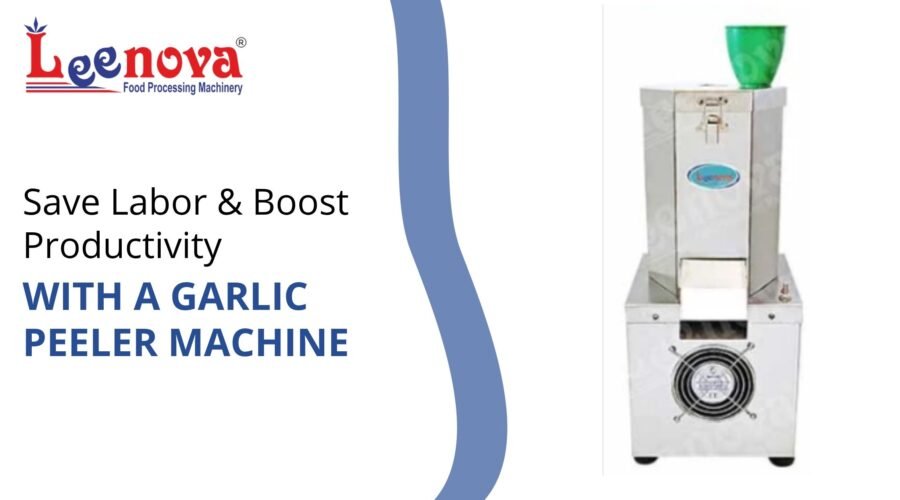Introduction
Peeling garlic by hand burns through labor hours faster than most kitchen managers realize. A single operator peels 20–30 kg per hour—at best. When you’re running a commercial kitchen, cloud kitchen, or processing facility, that bottleneck kills productivity, drives up costs, and leaves your prep staff with blisters and garlic burns.
A garlic peeler machine changes the equation completely. It processes 50–300 kg per hour depending on capacity, cuts labor costs by up to 95%, and eliminates 97% of manual peeling time. That’s not incremental improvement—it’s a complete workflow transformation.
This post breaks down how garlic peeler machines work, what they deliver in real operational terms, and how to choose the right capacity for your kitchen. You’ll see concrete productivity numbers, cost comparisons, and the key features that separate functional machines from high-value investments.
What is a Garlic Peeler Machine?
A garlic peeler machine automates the removal of garlic skin from individual cloves. It uses rotating barrels, pneumatic air pressure, or rubber friction surfaces to separate the peel without damaging the clove.
Types of Garlic Peeler Machines
- Dry peeling machines use compressed air and rubber rollers. They don’t require water, produce less waste, and deliver cleaner output.
- Wet peeling machines use steam or water jets to soften the peel before mechanical removal. They’re gentler on cloves but require drainage and generate wet waste.
- Semi-automatic models need an operator to load batches manually. Fully automatic machines run continuously with conveyor feeding.
How Garlic Peeler Machines Work
The process starts with pre-separated garlic cloves (most machines don’t peel whole bulbs). You load cloves into the feeding chamber.
Inside, rotating rubber-lined cylinders or discs apply friction to the cloves. High-velocity air blasts separate the loosened peel from the garlic.
Peeled cloves exit through one chute. Skin and debris exit through another, powered by air suction or gravity separation.
Benefits of Using a Garlic Peeler Machine
Labor Savings and Cost Reduction
One garlic peeling machine replaces the equivalent of 250 manual workers per hour. Labor cost drops by 95% compared to hand peeling—a savings of ₹16.11 per kg in operating costs.
If your kitchen processes 50 kg of garlic daily, you’re looking at annual labor savings of ₹2,93,000+ just on peeling.
Increased Peeling Speed and Throughput
Manual operators peel 20–30 kg per hour. Small commercial machines process 50–100 kg per hour. Industrial models handle 200–300 kg per hour.
That speed difference allows you to prep a full day’s garlic in under an hour, freeing up staff for cooking, plating, and service.
Improved Hygiene and Food Safety
Stainless steel construction prevents contamination. Enclosed peeling chambers reduce hand contact with food.
No more garlic juice on prep surfaces, cutting boards, or operators’ hands. The entire process stays inside the machine.
Consistent Quality and Reduced Damage to Cloves
Manual peeling damages 8–12% of cloves through bruising and breakage. Machines reduce damage to under 5% with optimized roller speed and pressure settings.
You get intact cloves with uniform appearance—critical for high-end restaurants and export processing.
Environmental Benefits of Dry Peeling
Dry peeling machines don’t require water, which cuts utility costs and eliminates wastewater disposal.
Peels come out dry and clean, making them easier to compost or dispose of compared to wet waste.
Key Features to Consider When Choosing a Garlic Peeler Machine
Peeling Capacity (kg/hr)
Match capacity to your daily volume. If you process 30–50 kg daily, a 50 kg/hr machine works. For 100+ kg daily, invest in a 150–200 kg/hr model.
Undersizing forces you to run multiple batches, which negates time savings. Oversizing wastes capital on capacity you don’t use.
Motor Power and Energy Efficiency
Most commercial machines run on 0.25–1.5 HP motors. Energy consumption ranges from 1.0–1.5 kW-h per batch.
Calculate your monthly power cost based on operating hours. A 1 kW-h machine running 3 hours daily costs ₹360–₹540 per month at ₹8/kWh.
Size and Portability
Table-top models fit kitchens with limited floor space. Floor-mounted units offer higher capacity but need dedicated areas.
Check footprint dimensions before purchasing. Most small machines occupy 2–3 square feet.
Material Construction
Stainless steel bodies resist corrosion, withstand moisture, and meet food safety standards. Avoid painted or mild steel units in high-humidity environments.
Rubber rollers should be food-grade and replaceable. Check availability of spare parts before committing to a brand.
Cleaning and Maintenance Requirements
Machines with quick-release barrels clean in 5–10 minutes. Models requiring disassembly take 15–20 minutes.
Daily cleaning prevents garlic residue buildup, which affects peeling efficiency and hygiene.
Applications and Suitability
Commercial kitchens processing 30+ kg daily benefit from semi-automatic machines. Large catering operations and hotel chains need fully automatic models with 100+ kg/hr capacity.
Pickle and sauce manufacturers require industrial-grade machines that integrate with conveyor lines. Vegetable wholesale markets use them for bulk pre-peeling before distribution.
Tips for Integrating a Garlic Peeler Machine into Kitchen Workflow
Place the machine near your prep station to minimize clove transport. Keep it close to a power outlet and ensure adequate ventilation for air discharge.
Train operators on proper loading techniques. Overloading reduces peeling efficiency and increases damage rates.
Schedule daily cleaning after the last prep shift. Monthly inspections of rubber rollers and air filters prevent performance drops.
FAQs
Can garlic peeler machines handle different garlic sizes?
Yes. Most machines have adjustable roller gaps and speed settings to accommodate small, medium, and large cloves. You may need to sort extremely large bulbs separately for optimal peeling.
Is wet peeling better than dry peeling?
Dry peeling is faster, cleaner, and produces less waste. Wet peeling is gentler on cloves and works better for garlic with very tight skin. For most commercial kitchens, dry peeling delivers better ROI.
How much maintenance is required?
Daily cleaning takes 5–10 minutes. Monthly checks include inspecting rubber rollers, tightening belts, and cleaning air filters. Annual servicing costs ₹1,500–₹3,000 depending on the model.
What’s the typical lifespan of a garlic peeler?
Stainless steel machines last 7–10 years with proper maintenance. Rubber rollers need replacement every 18–24 months depending on usage intensity.
How to ensure minimal waste during peeling?
Use pre-separated cloves, avoid overloading, and set roller speed based on clove size. Well-maintained machines achieve 95%+ peel separation with under 5% clove damage.
Conclusion
Manual garlic peeling costs you labor hours, slows prep, and drains profitability. A garlic peeler machine cuts peeling time by 97%, reduces costs by 95%, and delivers consistent output without hand fatigue or injuries.
Calculate your daily garlic volume, match it to the right machine capacity, and factor in labor savings over 12 months. The ROI speaks for itself.
Leenova Kitchen Equipment supplies garlic peeler machines engineered for Indian commercial kitchens—built for continuous operation, easy maintenance, and real-world productivity gains. We match the right capacity to your volume, not your budget alone.
Visit us at leenovakitchenequipments.com or call for a free kitchen workflow consultation. Let’s turn your biggest prep bottleneck into your fastest process.


